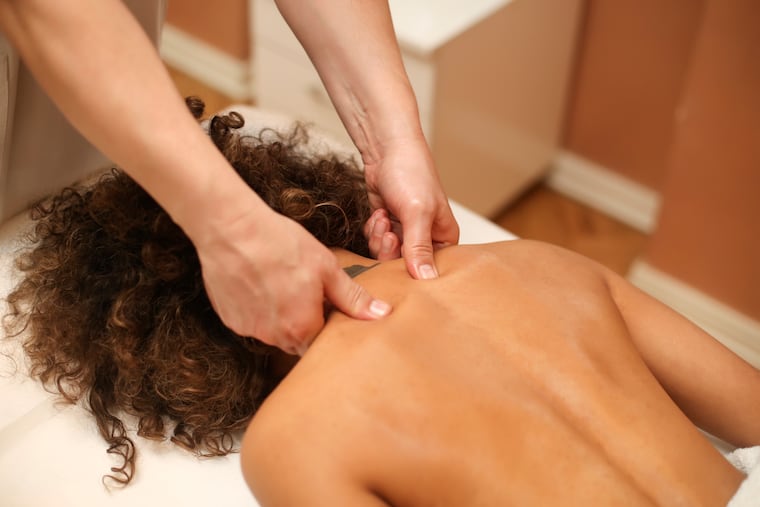Can I get a massage right now? Here’s how to think about the risk.
Spas and wellness centers have reopened across Pennsylvania, operating at 50-percent maximum capacity. But while you can now have a professional work out all those knots, is it really a good idea?

Tense year, tense muscles.
In a year marked by a global pandemic, widespread unemployment, economic downturn, racial unrest, and a divisive and long presidential election, there are plenty of reasons to be stressed. And by now, you may be feeling it not just mentally and emotionally, but physically.
Anyone else craving a massage?
Spas and wellness centers have reopened across the state, operating at 50-percent maximum capacity. But while you can now have a professional work out all those knots, is it really a good idea?
You can get a massage, but should you?
“You can weigh the risk similar to a barbershop or salon,” says Usama Bilal, assistant professor in the Urban Health Collaborative and department of epidemiology and biostatistics at Drexel University. “As long as there are measures put in place to ensure safety, these activities seem to be lower risk than some indoor activities, such as [going to] restaurants and bars.”
Just like getting a haircut, a massage is considered less risky than dining out mask-less amidst crowds. But there are still plenty of risk factors: You’ll be indoors, usually in a small room, for upwards of 30 to 90 minutes. And there’s no staying six feet away from the massage therapist.
As a result, you should always be mindful of COVID-19 rates. Currently, those are increasing both locally and nationwide, and the reality is, numbers aren’t predicted to get much better this winter.
“It’s a risk-benefit scenario, but right now with the percentage of positive tests we’re dealing with in Pennsylvania, the risk probably outweighs the benefit,” says Krys Johnson, an epidemiologist and assistant professor at Temple University. “I personally invested in a hand-held massager from Amazon. You can get ones with longer handles so you can reach your back.”
» READ MORE: How to give yourself a massage at home
Even with low to moderate community transmission, if you’re considered high-risk, or you’re regularly in contact with someone who is high-risk, the Centers for Disease Control and Prevention advises that you take extra precautions. In other words, wait on booking a massage.
If you do choose to go for it, there are ways to at least lower some of the risk.
Call ahead to ask what preventative measures the spa is taking.
All spas should follow CDC and state-issued guidance, which covers topics like cleaning practices, staff training, and mask usage. Appointments are strongly encouraged, and in Philadelphia, where there are a few additional rules, appointments are required.
“It would give me more confidence if they have protocols in place that they can communicate to you,” says Bilal.
If they have little to say about safety measures, consider that a red flag that they’re not taking the rules seriously. Pay attention to details about how often the spa disinfects high-touch surfaces, if they’re doing anything to increase ventilation, and what they’re doing to limit people in the waiting room.
Snag the first morning appointment.
As if you needed an excuse to skip that morning run, now you’ve got an inviting replacement: Safer relaxation.
“You really want the first appointment after they’ve had a couple days off — so if the spa’s closed Sunday and Monday, you want the first slot on Tuesday,” says Johnson. “That gives the therapist some time to know if they may have [COVID-19] symptoms and gives time for particles in the air to settle.”
Wear a mask, the entire time.
It doesn’t matter if you’re lying face up or face down — you need to keep that mask on.
“Masks can feel constricting, particularly if you have everything pushed up around your face, but you need to wear a mask,” says Johnson. “And you should probably plan to wear a surgical mask because it’s been proven to filter out more particles than cloth masks.”
Masks are a requirement for all spa staff. But if you see your massage therapist’s mask below their nose, speak up at the start, and kindly ask them if they’ll adjust it. To be effective, masks need to be worn properly.
Skip the facial.
Experts recommend steering clear of anything that requires you to remove your mask.
“You’re really close, and those respiratory droplets can travel. You want to minimize that,” says Bilal.
Consider in-home options.
If it’s feasible, hiring a massage therapist to come to your house may be a better option than going to a spa.
“You can control your own environment. You know what your disinfectant procedures are. You know your ventilation and whether you can open a sliding door to add more fresh air,” says Johnson. “So it may be safer, but you’re still bringing someone into your home who you’re not sure of.”
First, you’ll need to assess your environment. Do you live in an older apartment building that may lack good ventilation? Are there a lot of other people living in your household? Is there a relaxing space where you can open a window? You want to make sure it’s safe for both you and the massage therapist.
Expert sources:
Usama Bilal, PhD, MPH, MD, assistant professor in the Urban Health Collaborative and department of Epidemiology and Biostatistics at Drexel University
Krys Johnson, PhD, MPH, epidemiologist and assistant professor at Temple University